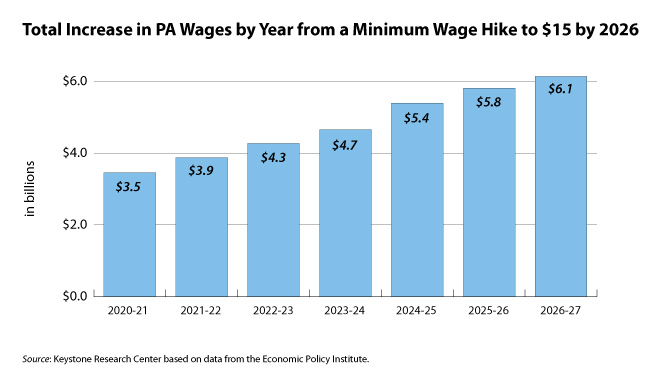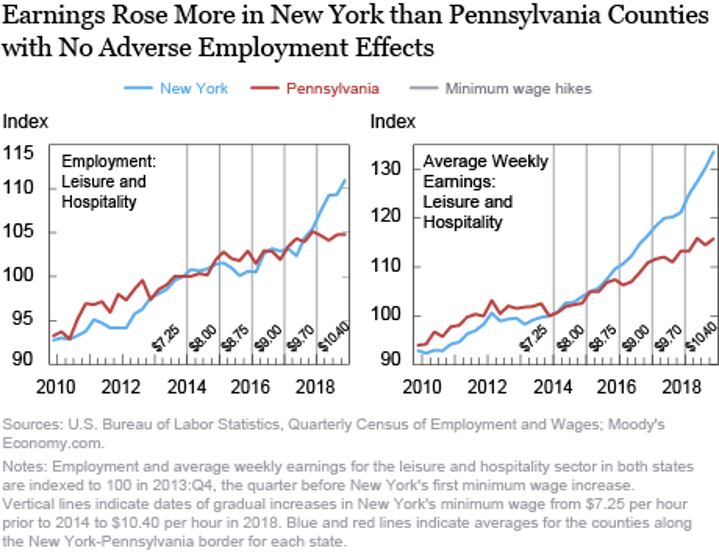Pennsylvania’s legislative majority failed to raise our minimum wage in 2019, rejecting House and Senate legislation to get to $15 per hour by 2025 despite support for an increase from a big majority of Pennsylvanians. In a press conference this morning, Governor Wolf started the bidding on a new proposal for a higher minimum wage—to $12 per hour on July 1, 2020, and then 50-cent annual increments to $15 per hour by 2026.
Just like the proposal last year, the governor’s new proposal would be a big winner for Pennsylvania workers.
Just over 1.8 million Pennsylvania workers would benefit by 2026, 1.1 million directly because they would otherwise earn less than $15 per hour in 2026, and another 0.7 million indirectly. The second group would earn over $15 per hour already in 2026, but get a bump or “spillover” increase from employers who value them enough to pay them above the new minimum.
The total annual wage increase injected into the Pennsylvania economy by the governor’s proposal would start at $3.5 billion per year (in 2018 dollars) and rise to $6.1 billion by 2026. That’s less than the $9.5 billion boost the economy would have gotten from last year’s $15 by 2025 proposal—but $6.1 billion is still real money and real consumer demand that Pennsylvania’s working families and businesses, small and large, could really use.
The people who benefit would be overwhelmingly (88%) adults 20 and over.
Those who benefit would be 61% female because women make up a larger share of lower-wage workers.
Most of the workers who would benefit from the governor’s proposal also come from families with modest incomes—55% with incomes less than $50,000, 83% with incomes less than $100,000.
As well as putting money in the pockets of people who will spend their wage increase, the governor’s proposed increase would not reduce employment. (You can find a comprehensive summary of the research on employment impacts here.) A fall 2019 study by NY Federal Reserve Bank analysts is especially relevant to Pennsylvania and shows that in some circumstances a minimum wage increase can actually increase employment. As we explained in this op ed, the NY Fed analysts’ study compared border counties in New York, where the minimum wage has risen a lot since 2013, with Pennsylvania border counties. In Pennsylvania, the minimum wage rose not all, in part because the conservative lawmakers in those rural areas failed to support an increase.
The Fed researchers looked at employment and wage trends in two low-wage industries: the leisure and hospitality industry and the retail sector. The picture below shows what they found in leisure and hospitality:
- Wages went up a lot faster in NY (by 25% if you adjust for inflation, which the Fed researchers didn’t) but only an inflation-adjusted 7% in Pennsylvania.
- Employment began going up at the same rate in the two states from 2013 to mid-2018 and then increased much faster in New York! One possible interpretation: with the gap in the minimum wage large by 2018 ($4 or more and still growing), more and more lower-wage Pennsylvania workers in rural border counties are going to New York to get decent jobs. By contrast, fewer and fewer New York border county workers are coming to Pennsylvania to take crap jobs.
Given the strength of the evidence on the positive wage AND employment effects of a minimum wage increase, rural Pennsylvania lawmakers should be leading the charge for Gov. Wolf’s new proposed path to a $15 per hour wage. If you live in one of these counties, give your lawmaker a visit and a call, and ask them why they favor lower wages and fewer jobs for their constituents who most need a raise!






